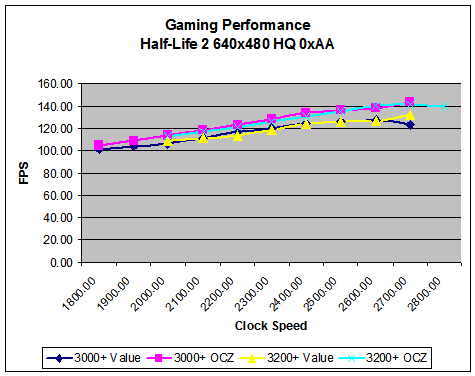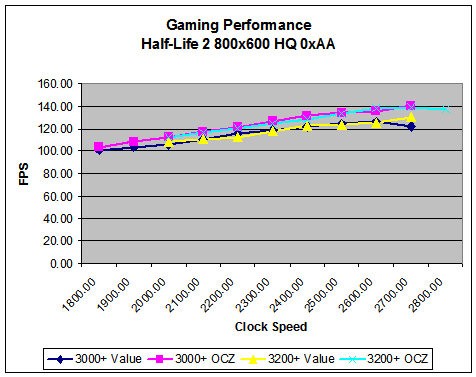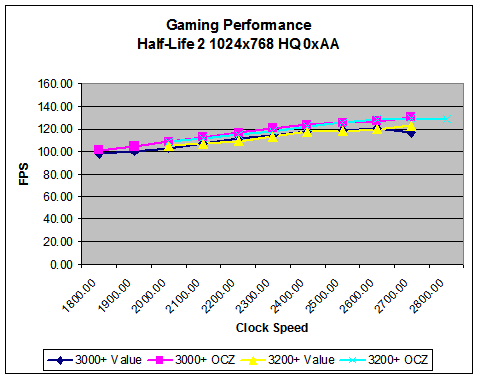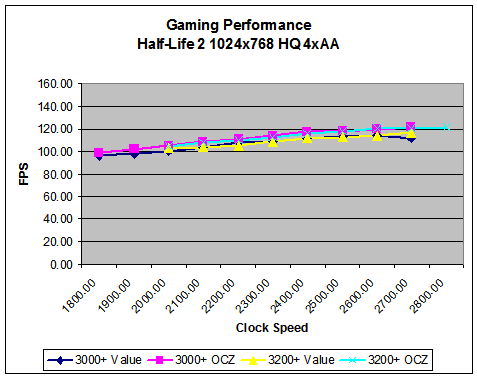Investigations into Socket 939 Athlon 64 Overclocking
by Jarred Walton on October 3, 2005 4:35 PM EST- Posted in
- CPUs
Half-Life 2 Performance
Just as Doom 3 favors NVIDIA performance, Half-Life 2 has done better on ATI cards. Our X800 Pro should provide more than playable results at all the tested resolutions, as HL2 really depends on GPU fillrate for performance. HL2 is also somewhat more CPU limited than other titles, which should give some good performance scaling with our overclocks. Future Source engine games making use of HDR will probably move the bottleneck back towards the GPU, judging by what we've seen in other HDR-enabled titles. Hopefully, Source can manage to provide more realistic HDR modes without cutting performance in half, but we're doubtful.
As with Far Cry, we benchmarked several levels and averaged the results; in this case, we used Anand's C17_12, Canals_08, Coast_05, Coast_12, and Prison_05 demos. Unfortunately, this may be the last time that we use those benchmarks, as the recent Steam upgrade has broken compatibility with revision 7 demos. All of these benchmarks were completed prior to the 9/23 update, luckily, but future overclocking articles will use different demos and will thus not be directly comparable with these scores. For the 22 graphs of the individual levels, we've once again created a Zip file.
In our biggest margin of victory, the OCZ RAM averages a 9% advantage over the value RAM. That's about the equivalent of a CPU upgrade (assuming that you don't overclock), at about the same cost as upgrading the processor. Like Far Cry, the 2T timing hurts performance. One of the things that you might have noticed is that the 10x280 setting has trailed behind the 2700 MHz configurations in most of the games. If we could get it running stably with 1T command rate, it would be better, but we were unable to accomplish this. The value RAM wouldn't even post at 10x280, so whatever limits that we're running into are at least lessened with higher quality RAM.
Just as Doom 3 favors NVIDIA performance, Half-Life 2 has done better on ATI cards. Our X800 Pro should provide more than playable results at all the tested resolutions, as HL2 really depends on GPU fillrate for performance. HL2 is also somewhat more CPU limited than other titles, which should give some good performance scaling with our overclocks. Future Source engine games making use of HDR will probably move the bottleneck back towards the GPU, judging by what we've seen in other HDR-enabled titles. Hopefully, Source can manage to provide more realistic HDR modes without cutting performance in half, but we're doubtful.
As with Far Cry, we benchmarked several levels and averaged the results; in this case, we used Anand's C17_12, Canals_08, Coast_05, Coast_12, and Prison_05 demos. Unfortunately, this may be the last time that we use those benchmarks, as the recent Steam upgrade has broken compatibility with revision 7 demos. All of these benchmarks were completed prior to the 9/23 update, luckily, but future overclocking articles will use different demos and will thus not be directly comparable with these scores. For the 22 graphs of the individual levels, we've once again created a Zip file.




In our biggest margin of victory, the OCZ RAM averages a 9% advantage over the value RAM. That's about the equivalent of a CPU upgrade (assuming that you don't overclock), at about the same cost as upgrading the processor. Like Far Cry, the 2T timing hurts performance. One of the things that you might have noticed is that the 10x280 setting has trailed behind the 2700 MHz configurations in most of the games. If we could get it running stably with 1T command rate, it would be better, but we were unable to accomplish this. The value RAM wouldn't even post at 10x280, so whatever limits that we're running into are at least lessened with higher quality RAM.










101 Comments
View All Comments
Crassus - Tuesday, October 4, 2005 - link
First of all, thank you for such a long article. I appreciate the work you put into this. What I'd really like to see in one of the planned articles would be an in-depth coverage of the options an enthusiast-grade mainboard BIOS offers nowadays for the RAM timings (and maybe PCIe) - beyond the standard timings covered in this article.PrinceGaz - Tuesday, October 4, 2005 - link
The finer memory-timings offered by enthusiast mobos are generally vendor specific so your best bet is to check a forum or other site dedicated to your motherboard. For DFI mobos for instance, you can find a thread which gives detailed coverage of memory settings on DFI-Street forums http://www.dfi-street.com/forum/showthread.php?t=2...">hereCheesePoofs - Tuesday, October 4, 2005 - link
Why stability test with 3dmark (an app that tries to stress teh CPU as little as possible) and pcmark (an ok pc-stressing app) instead of the combo of memtest86+, superpi, and prime95? Seems to me that if you want to find out whether yoru CPU really is stable, you'd want to stress it as hard as possible (which those three will do).Also, from what I've read from Zebo's thread in the CPU forums, 2T really doesn't have a significant impact on performance. Could you clarify this?
JarredWalton - Tuesday, October 4, 2005 - link
I've seen systems that run Prime95 and SuperPi 100% stable crash under 3DMark looping, as well as under PCMark. I imagine 2.80 GHz will crash under those if I run them all concurrently. My personal experience is that SuperPi and Prime95 only stress a few paths of the CPU, hence the inclusion of benchmarks with 11 different applications that can all fail with an unstable overclock. 3DMark GPU tests are not as demanding of the CPU, but the CPU tests are very demanding IMO. (That's part of why the top scores on the 3DMark ORB never include the CPU tests.)2T command rate, as you can see in quite a few instances, really killed performance. Perhaps tweaking other special timings beyond CL, tRCD, tRP, and tRAS might make the impact less, but you could likely tweak the same things with 1T at a lower memory speed. Command rate comes into play on every single memory access, so doubling that delay will certainly have an impact on performance.
fitten - Tuesday, October 4, 2005 - link
Good answer. Most have no clue as to how a CPU actually works. Ideally, a synchronous circuit is rated at a clock speed that the longest path will function properly (give correct results). There may be 1000s of pathways that can run at higher frequencies but that one can hold it back. Running the clock rate up may cause that one pathway not to be able to meet something like a data setup and hold time on one line (of the 32 or 64) in the data path and now you have an unstable setup that you may not detect. As always with overclocking, a crash is the best result you can get because you know you've pushed too far. Unless you are testing pretty much every instruction with every possible data against a control to compare against (some pathways can take longer depending on the data that it is being operated on), there are many errors that you may not detect... and all it takes is one, out of the possible billions, to make your machine not stable. Sure, it may be a rarely seen case of instruction+data but it exists.Programs like the Pi calculators and such do make your CPU work a lot, but the calculations are fairly repetitive and hardly a broad sample of the ISA.
I'm all for doing whatever you want with your own machine. Heck, I used to overclock all the time, too. I just find all of the lack of knowledge in synchronous circuits... interesting... when people talk about overclocking.
Saist - Monday, October 3, 2005 - link
for those who read this portion here :****
Because of the GPU limitation, we're going to be testing at 640x480, 800x600, and 1024x768. We'll also test many of the titles with 4xAA enabled, which should serve as a reality check. Even with a super fast CPU, many games are going to be completely GPU limited with the X800 Pro when we run 4xAA, especially at resolutions 1024x768 and above. Frankly, we wouldn't bother enabling 4xAA unless you can at least reach 1024x768 anyway.
****
Did anyone else think... okay.. lets stick a Radeon 9600, GeforceFX, or XGI Volari in there so that we actually will be limited? I mean... please. X800 alone goes above what most users have in their systems today. If we are buying "new" components, then yeah, the X800 is on my short list, but how about doing some reviews over hardware people actually have in their hands.
OvErHeAtInG - Tuesday, October 4, 2005 - link
If you're overclocking a new A64 Venice... somehow I think you're not still running your XGI Volari for games. Remember bench numbers are really only useful if they reflect framerates you would actually want to play with.JarredWalton - Tuesday, October 4, 2005 - link
The reason I used an X800 Pro is because I feel it's a good match for the chip, RAM, and motherboard. I can toss in a 7800GTX to show what the CPU on its own is capable of, but you can get cards that pretty much equal the X800 Pro for under $200. X800 GTO and GTO2 can match and even beat the X800 Pro.I view overclocking (and computer building in general) from a bang-for-the-buck perspective. It doesn't make sense to me to spend $100 upgrading from the 3000+ to the 3500+ if I'm going to be completely GPU limited. $200 on a graphics card is not that much money, when you really get down to it. 180 million transistor chip with 256MB of 980MHz RAM, all mounted on a large PCB? At least I can feel I'm getting a lot of stuff for $200. A CPU is far cheaper to produce (though more expensive to design). Profit margins on CPUs are notoriously high.... Personally, the X800 Pro is a decent card, but I really want something faster these days. Same goes for the 6800GT. But then, not everyone feels that way.
---------
Thought #2 (for Saist): If X800 is above what most people have, other than those buying new computers... well, what about the motherboard and processor? Socket 939 with nForce4 is a more recent configuration than X800/6800 cards. Not to mention Venice has only been out for something like 8 months.
If you're looking to spend $120+ on a new Venice chip and you've only got a 9600 Pro (or even a 9800 Pro), you're wasting your money on the wrong part (at least from a gaming perspective). A socket 754 Sempron with an X800 Pro would be far better for gaming than a Venice core with anything less than an X800/6800. Outside of gaming... well, graphics don't matter outside of gaming much, which is why Winstones, PCMark, and AutoGK are included.
Honestly, I'm not entirely sure if you were complaining about the use of a GPU that was too fast, or that it wasn't fast enough. For frequent gaming, I wouldn't recommend anyone go lower than about the X800 GTO these days. 6600GT is (IMO) now relegated to the budget/moderate-gaming setup, as many games are simply unplayable above 1024x768. I really don't like to drop below 1280x1024/1280x960 if I can avoid it. If I've misunderstood your complaint, let me know; if we simply have a difference of opinion... well, there's not much to do about that. :)
yanman - Tuesday, October 4, 2005 - link
any chance you can add in benches for 7800GT/GTX? after all, in your discussion you correctly asset that money is much better spent on high spec'd GPU to match the cpu speed that you've managed to overclock to - having used bargain rate ram and venice.i have a venice 3000+ clocked at 2686mhz, 7800gt and 2x1gb sticks of average ram (legend/hynix). until i upgraded the ram a few weeks ago i had it running for prehaps a month and a half totally solid with 2x512mb sticks of same type, at 2696mhz (337x8, ram at 225mhz (2:3) 2.5-3-4-7-1T)
the reason i ask for 7800GT and GTX is 2 fold, so we can see it from an nvidia side too (different cpu scaling maybe?), and also to show the scaling for a top-end card even if only as a reference point. It just seems a bit one-dimensional only using 1 card.
One last thing, well done to Zebo who made the excellent "Quick and dirty A64 overclocking guide" (used to be sticky in the forums) which I and many people I know used to overclock their venices with.. i'd be stuck without it!
JarredWalton - Tuesday, October 4, 2005 - link
I'm planning on doing 7800GTX testing with an X2 3800+ OC article. For gaming, it will perform identically to the 3200+ Venice. Hopefully, I'll be done in the next ~week or so.